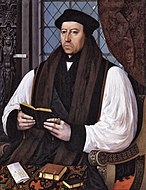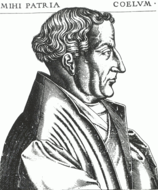User:Pbritti/archived/Edwardine Ordinal
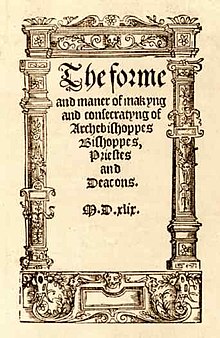
The Edwardine Ordinal[note 1] may refer to two ordinals primarily written by Thomas Cranmer as influenced by Martin Bucer and first published under Edward VI, the first in 1550 and the second in 1552, for the Church of England. Both liturgical books were intended to replace the ordination liturgies contained within medieval, pre-English Reformation pontificals. The 1550 ordinal was authorized following the introduction of the first Book of Common Prayer a year prior and the 1552 ordinal's introduction coincided with the second Book of Common Prayer–both also largely prepared by Cranmer. The ordinals provided the basis for most Anglican ordination rites until the 20th century and helped effect the development of the Anglican priesthood from "sacerdotal" and "intercessory" into a "preaching, catechizing, and protestant ministry".[5]: 713 They also formed the basis for both the Vestiarian Controversy and, much later, some of the debate over the validity of Anglican Holy Orders and the subsequent 1896 papal bull Apostolicae curae where they were declared "absolutely null and utterly void" by the Catholic Church.
Medieval ordination liturgies
[edit]| Part of a series on the |
| History of the Church of England |
|---|
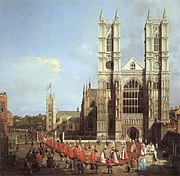 |
The word Ordinal in the Medieval period, rather than applying to a liturgical book containing the rites of ordination, was the title given to a text associated with the recitation of the canonical hours which was eventually assimilated into the breviary.[6]: 2 While it is the typical name modern name in reference to texts containing ordinations, it was probably not until John Bramhall's 1636 The consecration and succession of protestant bishops justified that "ordinal" was used in this context.[3]: cxxx
Prior to the English Reformation, the liturgies of ordination–for the conferral of Holy Orders–in the Latin liturgical rites were contained within several versions the pontifical, most prominently the Roman Pontificals of the Roman Rite and the Sarum Pontifical of the Sarum Use. These ordination liturgies were a matter of debate between Rome and Reformers; 17th-century scholar Jean Morin summarized the Catholic Church's position that the contemporary Roman Pontificals "omit[ted] nothing that was present in the older" pontificals,[7] while Anglicans have suggested that the laying on of hands by consecrators were variously deleted or obscured by other rituals.[8]: 264–265 [9]: 56
The Gallican ordination liturgies, which had influenced broader Roman Rite practices in the early medieval period, were ritually complex but also possessed clear moments of ordination. As early as the 10th century, English pontificals would feature a litany that accompanied ordination liturgies.[10]: 788 For priestly ordination, the bishop laying of hands on a candidate would say it was "the blessing of the presbyterate". The anointing of a priest's hand with chrism appeared within Gallican and Roman liturgies, including the 11th-century Leofric Missal.[8]: 262 Medieval texts–besides containing the rituals for ordinating deacons, priests, bishops–also included means for conferring minor orders such as the subdiaconate.[8]: 263
Medieval pontificals gradually included and emphasized the conferral of the vestments and other items associated with their new offices, among these being stoles, patens, and chalices, in a custom known as the "tradition of elements" (Latin: traditio instrumentorum).[11]: 131–132 [12]: 5 In 1439, this practice was identified by Pope Eugenius IV as an essential part of ordination.[10]: 785–786 These medieval practices and their convoluted nature–duplicated actions were common within the ordination Masses–were the result of Roman and Gallican rites being conflated with local permutations. It was not uncommon for elements to be inserted into ordination liturgies that were associated with neither the formal texts or the liturgical actions.[13]: 529
First Edwardine Ordinal
[edit]With the English Reformation and independence of the Church of England from Rome, Henry VIII mandated that the oath of obedience to the pope be deleted from the Sarum and Roman pontificals still in use; these modifications can be seen in some preserved copies of these texts.[14]: 228–229 [note 2] In 1547, a meeting between parliament and convocation resulted in an act of convocation that permitted clerical marriage in the Church of England.[15]: 251 However, no wholly revised ordinal immediately accompanied the 1549 Book of Common Prayer and the Church of England continued to use the Sarum ordination form for the first year of the prayer book's authorization.[16]: 259
German reformer Martin Bucer–who had been exiled to England in 1548–drew on the discussions that had already occurred among his fellow reformed countrymen in Germany regarding the role of the priesthood and compiled an ordination liturgy in Latin, De ordinatione legitima ministrorum ecclesiæ reuocanda, for the English reformers to study.[10]: 786 [3]: cxxxi Thomas Cranmer, the Archbishop of Canterbury and liturgist behind the 1549 prayer book, would perform an ordination with Nicholas Ridley, the Bishop of London and Westminster, at St Paul's Cathedral in 1549 according to the ritual soon to be legally codified.[17]: 120
The authorization and production of an ordinal was formally requested in a House of Lords bill on 8 January 1550 and authorized by an act of Parliament on 31 January that mandated its preparation under the authority of the king "before the first day of April" of 1550. A commission was set up to authorize a form for the new ordinal. Nicholas Heath, a moderate Catholic and the Bishop of Worcester, is the only person known to have been on the commission; Heath was imprisoned 18 months for refusing to sign off on the ritual form produced for the commission. The ordinal was completed and published by 25 March that year,[note 3] with the liturgy accompanied by a literary preface.[6]: 8 [18]: x [13]: 528 This form, largely arranged by Cranmer, was derived from Bucer's work with some additions traced to Martin Luther and featured some "personal creative contribution" from Cranmer.[12]: 5 The authorized ordinal was printed by Richard Grafton, bound separately from the prayer book, under the full name A forme and maner of makyng and consecratyng of Archebisshopes, Bisshopes, Priestes and Deacons.[10]: 786 [5]: 715 [note 4]
The Sarum ordination liturgies were the foundations of this ordinal, as the revisers did not have the means to review the precedents to the contemporary Sarum usage. As such, the 1550 ordinal was largely a simplification of those rituals with an intent to emphasize the imposition of hands and associate prayers, including the ancient hymn Veni Creator Spiritus.[20]: 71 Additionally, the minor orders were wholly deleted in favor of what were deemed the "necessary" orders of deacon, priest, and bishop. According to the ordinal's preface, this was based on an interpretation of Scripture and ancient tradition that established a "existence of the threefold ministry" during the Apostolic age.[21]: 22 The examination of candidates, which in the Sarum Use had been exclusive to episcopal consecrations, was also extended to the candidates for the diaconate and priesthood.[6]: 117–118
The essential elements of the ordination liturgy were interpolated into a Holy Communion office that included Cranmer's litany.[10]: 786 As with the medieval ordination Masses, these elements were dispersed throughout the 1550 ordinal liturgies with less attention to cohesion than inclusion of the actions; there is a different ordering of share events within the three ordination rites relative to the Holy Communion office.[13]: 529 Laypersons could and would attend ordinations, with an opportunity for those gathered to "declare 'any impediment'" and give negative endorsement of the candidates to prevent their ordination.[5]: 715
The 1550 ordinal retained the practice of giving a newly-ordained priest certain items, with the addition of a Bible in addition to paten and chalice.[19] Among the requirements for an ordinand present in the 1550 ordinal were that they be educated and intimately connected with their community. This requirement proved a challenge among clergy emanating from Wales and the linguistic and cultural frontiers on the border between England and Wales–particularly in the Diocese of Hereford–as many English-speaking clergy had trouble communicating with the local Welsh-speaking laity.[5]: 713–714 In Ireland, Reformation efforts were decelerated by stalled efforts to translate and print Anglican liturgies in the country and its language. Among the instances of these was a failure to introduce the ordinal alongside a 1551 printing of the prayer book.[22]: 120
The ordinal was not received positively from Catholic bishops in England. Despite accepting the 1549 prayer book, Nicholas Heath refused to accept the 1550 ordinal, as he believed that it eroded the Church of England's catholicity. He was deprived of his bishopric at Worcester and imprisoned.[23] A similar fate befell the Catholic Stephen Gardiner.[22]: 82
Episcopal consecration
[edit]The ordering and contents of the 1550 form for consecrating bishops differed from both that present in the Sarum Pontifical and and Bucer's Latin liturgy:[3]: cxl
| Sarum Pontifical[note 5] | Bucer | 1550 |
|---|---|---|
|
| |
|
|
|
|
|
|
| ||
|
|
|
Second Edwardine Ordinal
[edit]
Resistance to the first ordinal was not exclusive to the Catholic party. John Hooper was nominated to become the Bishop of Gloucester on Easter 1550, but refused to be consecrated in accordance to the vestments–a surplice and rochet–which were prescribed by the 1550 ordinal.[26] He further rejected an oath within the ordinal which made reference to the saints having publicly pronounced as much on 5 March in a sermon on Jonas.[3]: clxiv–clxv At the urging of Cranmer and Ridley–and following internment at Fleet Prison–Hooper acceded to being consecrated and became a bishop in a legal ceremony on 8 March 1551.[27] This incident would form the basis of the long-running Vestlarian Controversy.[17]: 122–123
Edward VI is said to have been so moved by Hooper's words that he personally struck the passage from the ordinal's oath; it would be the modified passage which appeared in the 1552 ordinal.[3]: clxiv–clxv [28]: 950–951 The ordinal, as authorized in the 1552 Act of Uniformity and inaugurated on 1 November, would drop the vestment requirement; ordinands would not be required to wear an alb.[22]: 60–61
"This day all copes and vestments were put downe through England, and the prebendaries of Pawles left of their hoodes, and the Bishops their crosses, so that all prestes and clarkes should use none other vestmentes, at service nor communion, but surplisses onely."
— Charles Wriothesley, Wriothesley's Chronicle, on the inauguration of the 1552 prayer book and ordinal[22]: 61
As with most later prayer books, the 1552 prayer book was now typically bound together with the ordinal; every parish in the Kingdom of England was legally required to purchase a copy 1552 prayer book.[10]: 786 [5]: 715 However, the ordinal retained its own title page and at least one printing gave it a separate 16-page foliation.[3]: cl
This new ordinal deleted the giving of items outside of the Bible to the priestly candidate;[20]: 71 the giving of the Bible a practice in the subsequent Church of England prayer books.[16]: 260 Reginald Pole, Catholic cardinal and Mary I's Counter-Reformation Archbishop of Canterbury, reiterated Eugenius IV's position that the tradition of elements that had been deleted in the 1552 ordinal were necessary for ordination.[10]: 786 These changes from the practices of the pontificals implied an alteration in the purpose of the priesthood, from a Catholic understanding a "consecrating" and "sacrificing priest" to one where an "Anglican priest is a presbyter, not a sacrificing priest."[21]: 28 Unlike certain portions of the 1552 prayer book that use the word "minister", the 1552 ordinal used the word "priest" for the presbyterial office. "Priest" was considered too "popish" by some English clergy and laity and by the late 16th century many would independently adopt "minister" as their preferred word for the station.[5]: 713
With the death of Edward VI in July 1553, the Catholic Mary I ascended to throne and initiated the Marian Persecutions against the English Reformers. Mary I restored a "Pre-Reformation Catholicism" and the medieval liturgical books in England during her 1553-1558 reign, suppressing the 1552 ordinal in favor of the Roman and Sarum pontificals. She further reintroduced the minor orders and deprived married clergy of their benefices.[5]: 715, 718 [15]: 254
Elizabethan restoration and revision
[edit]Following Elizabeth I assuming the throne and the Elizabethan Religious Settlement's return of Reformation values, the 1552 ordinal that had accompanied the 1552 prayer book was thought to have been authorized under the 1559 Act of Uniformity. However, William Cecil, Elizabeth's Secretary of State, advised the queen that the act made no mention of the ordinal and that Thomas Cranmer's ordination liturgy was illegal.[29]: 13–14 Despite this, the text was accepted alongside with the subsequent 1559 Book of Common Prayer;[10]: 786 though, unlike in 1552, the "orphaned ordinal" would not appear in the table of contents of the 1559 prayer book and instances of the ordinal not bound with the prayer book comprise the sole extant copies of at least one printer's ordinals. It is possible that the ordinal was intended for sale independent of the 1559 prayer book.[30]
The religious situation of the Elizabethan period saw a significant degree of nonconformism and associated tendencies towards Presbyterianism alongside Catholic recusancy. In 1562, the pope had forbade Catholics from attending Church of England services while some Calvinist rejected the official liturgies on their own theological grounds.[19]: 56 John Whitgift became Archbishop of Canterbury in 1583 and, despite his Calvinist deferences, supported the "orthodoxy" of the Church of England in its view priesthood as a sacred office as defined in the Book of Common Prayer and the ordinal's ritual for ordaining priests and consecrating bishops.[20]: 70–71 [note 10]
In 1604, a canon was appended to specify the minimum age of a candidate for the priesthood and mandated that all candidates to that office hold a university degree.[10]: 788 In preparation for the 1661 prayer book revision, John Cosin annotated his personal copy of the 1552 ordinal.[10]: 786 The most significant deviation between the second Edwardine ordinal and the ordinal as contained within the 1662 Book of Common Prayer was the phrasing in the imperative formula in the episcopal and priestly ordinations; these were expanded to included reference to the particular office a candidate was being ordained to.[4]: 22–24 Unlike prior editions, the ordinal was not only bound together with the 1662 prayer book but considered a part of the prayer book.[10]: 786
Later influence
[edit]Following the Anglican Church of Australia's adoption of An Australian Prayer Book in 1978 and the introduction of the ordination of women, longtime Moore Theological College principal Broughton Knox fostered a movement in Sydney that saw deference towards the 1552 conceptualization of the priesthood. This saw an increase in lay ministration, an aversion to "cultic" sacramental and charismatic worship, and "exclusive" congregationalism.[31]
Tthe traditio instrumentorum remained excluded from most Anglican ordination rituals following the 1552 ordinal, though it was reintroduced as an optional ceremony within ordinations according to the Church of England's Common Worship. There, the vessels are presented before the Holy Communion so that they be used within the liturgy.[12]: 20
Debate over validity of ordinations
[edit]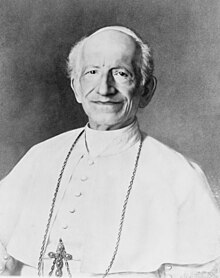
Among the reasons cited by Catholics in the 19th and 20th century in asserting Anglican orders were invalid were the Edwardine Ordinals and their formulae. The Edwardine Ordinals, according to the Catholic position, failed to proclaim that candidates were being raised to a "sacrificial office" in the ordination to the priesthood and episcopate.[32] This "defect of form" within the Edwardine Ordinals, in association a "defect of that intention" present in at least the 16th century required for ordination, were evaluated by Pope Leo XIII as invalidating Anglican Holy Orders in his papal bull on the matter, the 1896 Apostolicae curae.[4]: 4 Additionally, the sacramental theology of the ordinals' authors were identified by Leo XIII as invalidating Anglican orders.[33]
Frederick Temple and William Maclagan–the Archbishops of Canterbury and York respectively–sent a response in 1897, Saepius officio, addressing the criticisms and arguments made in Apostolicae curae. This letter was not received with much notice and has been given little academic consideration despite its direct disputation of Leo XIII's points. Of particular note were its liturgical discussion and the authors' belief that the papal bull would find defects "in the catechisms of the Oriental Church".[34][33]
The preface to the 1552 also drew Catholic criticism. Unlike the 1552 ordinal's form, which Catholic authorities held were "definitively and unambiguously heretical", the preface was "ambiguous" on certain matters of doctrine, namely that of the Eucharist. The belief priests are able to transubstantiate the Eucharist rather than simply perform a "commemorative ritual feast" is considered a necessary component of valid ordinations; the lack of specificity in the 1552 ordinal's preface has been presented as potential evidence of an implied deficient theology.[35]
The matter of whether certain bishops from whom later Anglicans derive their apostolic succession were consecrated according to the 1552 ordinal or revived Sarum Pontifical was another point of debate. One such challenged consecration was that of Matthew Parker, who became Archbishop of Canterbury in 1559. Despite some 20th-century efforts to place Parker's consecration in October 1559 and thus according to the Sarum Pontifical, later review have placed the date in December and determined it was according to the second Edwardine Ordinal.[36]
See also
[edit]- Anglican Communion
- Primer (prayer book)
- Scottish Prayer Book (1929)
- The Sunday Service of the Methodists
Notes
[edit]- ^ The adjective "Edwadine" makes reference to Edward VI, the Tudor King of England under whom the ordinals were produced. While "Edwardine" is the typical spelling when collectively referencing the 1550 and 1552 ordinals,[1] "Edwardian" may also be used (though this latter spelling typically refers to Edward VII).[2] "Ordinal" itself is an anachronism with regards to the Edwardine Ordinal, as the word was not first applied to such texts until the 17th century.[3]: cxxx Additionally, "Edwardine Ordinal" may refer to either the 1550 or 1552 ordinals independent of one another.[4]: 23
- ^ Not all pontificals were defaced in accordance with Henry VIII's declaration. As they were never printed and were the property of the bishops rather than parishes, pontificals were never called in and continued to be used at the discretion of the bishops.[3]: cxxx
- ^ Because of its publication before 25 March, its title page is dated to 1549.[5]: 715
- ^ The same year as the first ordinal's approval and publication, John Merbecke published his The Booke of Common Praier Noted, a highly-successful musical setting of the 1549 prayer book that drew on a common 14th-century Folk Mass; Merbecke's text emphasized the role of the congregation.[19]: 50–51
- ^ Derived from a Sarum Pontifical as printed within William Maskell's Monumenta Ritualia Ecclesiae Anglicanae, Vol. III.
- ^ A statement regarding the duties of a bishop attributed to Isidore of Seville, likely instead originating in Celtic or Gallican practice.[24]
- ^ Prayer reads in full as "Manus Dei omnipotentis Patris Filii et Spiritus Sancti sit super vos, protegat et gubernet vos, ut eatis et fructum vestro ministerio quamplurimum afferatis, isque maneat in vitam æternam, amen."[25]
- ^ While the ordaining of priests is accompanied by the prayer "Receive the Holy Ghost: whose sins..." as derived from John 20:22, the consecration of bishops reads "Take the Holy Ghost: and remember that thou stir up..." as derived from 2 Timothy 1:6-7.[25]
- ^ The rubric in 1550 read "The Archbishop shall lay the Bible upon his neck, saying 'Give heed unto reading,' &c.; secondly, There shall the Archbishop put into his hand the pastoral staff, saying 'Be to the flock of Christ a shepherd...'" This retention of the tradition of elements would be modified in 1552 with a full deletion of vestments.[25]
- ^ The late 16th century featured several nonconformist Protestant alternatives to the Book of Common Prayer and the Church of England's other approved texts, sometimes secretly used inside England. Among the most prominent of these was John Knox's adaption of John Calvin's La Forme des Prières that developed into the Book of Common Order which was approved by the Scottish Assembly in 1564.[20]: 71
References
[edit]- ^ Lowndes, Arthur (1897). Vindication of Anglican Orders. Vol. 1. New York City: Edwin S. Gorham. p. 71.
- ^ Dart, John Lovering Campbell. Anglican Orders and the Papal Decree of 1948: On the Matter and Form of Holy Orders. London: Church Literature Association – via Project Canterbury.
- ^ a b c d e f g h Brightman, Frank Edward (1915). The English Rite: Being a Synopsis of the Sources and Revisions of the Book of Common Prayer (PDF). Vol. 1. London: Rivington. Retrieved 30 August 2022 – via Society of Archbishop Justus.
- ^ a b c Puller, Frederick William (1908). The Bull Apostolicae Curae and the Edwardine Ordinal. The Church Historical Society. Vol. XVI. London: Society for the Promotion of Christian Knowledge – via Google Books.
- ^ a b c d e f g h Hayes, Gianetta M. (October 2005). "Ordination Ritual and Practice in the Welsh‐English Frontier, circa 1540–1640". Journal of British Studies. 44 (4). Cambridge University Press. Retrieved 28 August 2022 – via JSTOR.
- ^ a b c Maude, J.H. (1949). The History of the Book of Common Prayer. Oxford Church Text Books (11th impression, 6th ed.). London: Rivington's.
- ^ Smith, Sydney (1907). "Anglican Orders". The Catholic Encyclopedia. Vol. 1. New York City: Robert Appleton Company.
- ^ a b c Pullan, Leighton (1901). Newbolt, W.C.E; Stone, Darwell (eds.). The History of the Book of Common Prayer. The Oxford Library of Practical Theology (3rd ed.). London: Longmans, Green, and Co.
- ^ Perry, William (1941). Guide to the Scottish Prayer Book (2015 reprint ed.). Cambridge University Press.
- ^ a b c d e f g h i j k Cummings, Brian (2011). The Book of the Common Prayer: The Text of 1549, 1559, 1662. Oxford World's Classics (2013 ed.). Oxford: Oxford University Press.
- ^ Perry, William (1929). The Scottish Prayer Book: Its Value & History (PDF). Cambridge: Cambridge University Press – via Society of Archbishop Justus.
- ^ a b c Kennedy, M.C. (2004). The Study of the Liturgy: The Ordinal, Book of Common Prayer 2004. Church of Ireland – via Issuu.
- ^ a b c Leggett, Richard Geoffrey (2006). "Anglican Ordinals". In Hefling, Charles; Shattuck, Cynthia (eds.). The Oxford Guide to The Book of Common Prayer: A Worldwide Survey. Oxford: Oxford University Press. ISBN 978-0-19-529762-1.
- ^ Walcott, Mackenzie Edward Charles (1851). The English Ordinal: Its History, Validity and Catholicity, with an Introduction on the Three Holy Orders of Ministers in the Church. London: Francis & John Rivington – via Google Books.
- ^ a b Spielmann, Richard M. "The Beginning of Clerical Marriage In the English Reformation: The Reigns of Edward and Mary". Anglican and Episcopal History. 56 (3). Historical Society of the Episcopal Church – via JSTOR.
- ^ a b Dearmer, Percy (1933). The Story of the Prayer Book in the Old and New World and Throughout the Anglican Church (1948 third impression ed.). London: Oxford University Press.
- ^ a b Smith, Ralph Burns (June 1948). "Chapter V: The Ordinal and other significant services". The English Books of Common Prayer (1549 - 1552 - 1559) (PDF) (Thesis). Rice Institute. Retrieved 31 August 2022.
- ^ Gibson, E.C.S. (1910). "Introduction". The First and Second Prayer Books of Edward VI (1964 reprint ed.). London: Everyman's Library.
- ^ a b c Morgan, Dewi (1961). 1662 and All That: Commemorating the Third Centenary of the Book of Common Prayer. London: A.R. Mowbray & Co. Limited.
- ^ a b c d Cummings, Brian (2018). The Book of Common Prayer: A Very Short Introduction. Very Short Introductions. Oxford: Oxford University Press. ISBN 978-0-19-880392-8.
- ^ a b Lampe, Geoffrey (1962). "The English Ordinal" (PDF). The Churchman. lxxvi. Retrieved 31 August 2022 – via Biblical Studies.org.uk.
- ^ a b c d Tong, Stephen Nicholas (16 April 2018). Evangelical Ecclesiology and Liturgical Reform in the Edwardian Reformation, C.1545-1555 (Thesis). Corpus Christi College, Cambridge.
- ^ One or more of the preceding sentences incorporates text from a publication now in the public domain: Pollard, Albert (1911). "Heath, Nicholas". In Chisholm, Hugh (ed.). Encyclopædia Britannica. Vol. 13 (11th ed.). Cambridge University Press. p. 157.
- ^ McMillan, Sharon L. (2005). Episcopal Ordination and Ecclesial Consensus. Publeo Books. Collegeville, MN: Liturgical Press. p. 143.
- ^ a b c Frere, Walter; Procter, Francis (1901). "Chapter XVI: The Ordinal". A New History of the Book of Common Prayer with a Rationale of its Offices (1910 ed.). London: Macmillan & Co. Retrieved 12 September 2022 – via Society of Archbishop Justus.
- ^ Cross, F.L.; Livingstone, E.A., eds. (1997). "Vestiarian Controversy". The Oxford Dictionary of the Christian Church (3rd ed.). London: Oxford University Press. p. 1689-1690. ISBN 0-19-211655-X.
- ^ Ryle, John Charles (1868). John Hooper (Bishop and Martyr) His Times, Life, Death, and Opinions. London: William Hunt & Co. p. 24-26 – via Google Books.
- ^ Brightman, Frank Edward (1915). The English Rite: Being a Synopsis of the Sources and Revisions of the Book of Common Prayer (PDF). Vol. 2. London: Rivington. Retrieved 30 August 2022 – via Society of Archbishop Justus.
- ^ Hughes, John Jay (1968). Absolutely Null and Utter Void: The Papal Condemnation of Anglican Orders, 1896. Washington, DC: Corpus Books.
- ^ Blayney, Peter W. M. (2021). "Chapter 7: The Orphaned Ordinal". The Printing and the Printers of The Book of Common Prayer, 1549–1561. Cambridge University Press.
- ^ Sherlock, Charles (2006). "The Anglican Church in Australia". In Hefling, Charles; Shattuck, Cynthia (eds.). The Oxford Guide to The Book of Common Prayer: A Worldwide Survey. Oxford: Oxford University Press. p. 327. ISBN 978-0-19-529762-1.
- ^ St. John, Henry (November 1937). "Faith and Order". Blackfriars. 18 (212). Wiley: 831. Retrieved 28 August 2022 – via JSTOR.
- ^ a b Tavard, G. H. "Apostolicae Curae". New Catholic Encyclopedia. McGraw-Hill – via Encyclopedia.com.
- ^ Geldhof, Joris (13 September 2016). "The role of liturgy in Apostolicae curae and Saepius officio". International Journal for the Study of the Christian Church. 16 (3).
- ^ Stephenson, Anthony A. (1956). Anglican Orders. Westminster, MD: The Newman Press. p. 9.
- ^ "'A noughtye and a false lyeng boke': William Barlow and the Lutheran Factions". Renaissance Quarterly. 31 (2). Cambridge University Press on behalf of The Renaissance Society of America: 182. Summer 1978. Retrieved 31 August 2022 – via JSTOR.
Category:1550 books Category:1552 books Category:Anglican liturgical books Category:Anglican theology and doctrine Category:Catholic–Anglican ecumenism Category:Edward VI of England Category:History of the Church of England

